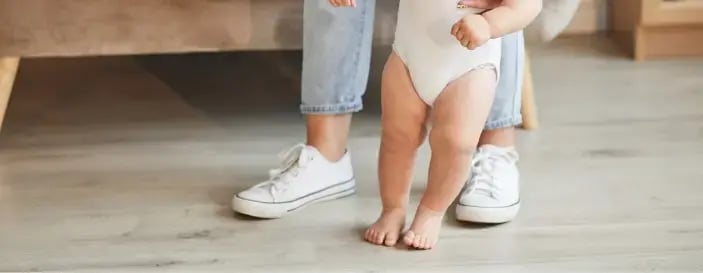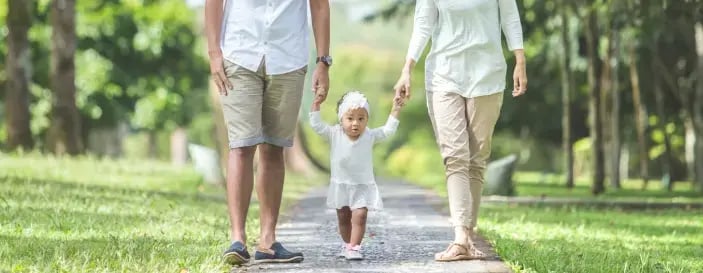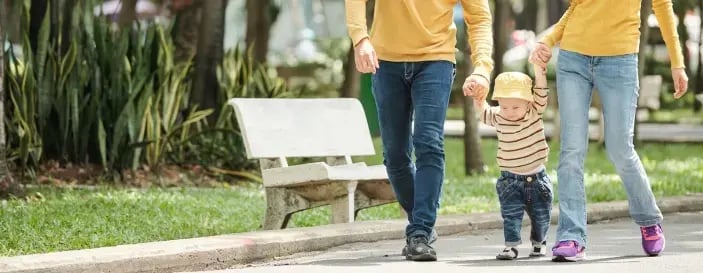When a baby is born with club feet, it can raise many questions and concerns for parents. Understanding the condition is the first step in addressing it effectively. This article outlines what club feet are, the possible causes, signs to watch for, available treatment options, and the outcomes parents can anticipate. By staying informed, parents can collaborate closely with healthcare professionals to provide the best care for their children.

What Are Club Feet?
Club feet, also known as Congenital Talipes Equinovarus (CTEV), is a congenital condition that affects the shape and positioning of a baby’s feet or foot. The affected foot or feet appear twisted out of shape, often pointing downward and inward, making it difficult for a child to walk properly if left untreated. Around 1 in every 1,000 babies* is born with club feet, and the condition can affect one or both feet.
It is important to note that while the appearance may seem concerning to new parents, club feet are treatable, and most children grow up to live active and healthy lives.
Signs of Club Feet in Babies
Club feet are typically noticeable at birth, and in many cases, can be detected through a prenatal ultrasound. Common signs include:
- Twisted Foot Shape: The baby’s foot points downward and inward, resembling the shape of a golf club.
- Abnormal Arches: The arch of the foot may be more pronounced or deformed.
- Shortened Foot Length: The affected foot may appear shorter or smaller than average.
- Calf Muscle Differences: On the leg with the affected foot, the calf muscle may appear underdeveloped.
In Hong Kong, paediatricians typically detect club feet during the newborn examination immediately after birth. If the condition is identified during an ultrasound or you observe any signs after birth, consult a doctor for an accurate diagnosis and prompt care.

What Causes Club Feet?
The exact cause of club feet isn’t fully understood, but research shows there are a few factors that may play a part:
- Genetics: There may be a hereditary component, as having a family history of club feet increases a baby's likelihood of being born with the condition.
- Environmental Factors: Conditions in the womb, such as decreased amniotic fluid, could contribute to the development of club feet.
- Neuromuscular Conditions: Club feet can occur as part of broader syndromes or neuromuscular disorders like spina bifida.
Club feet are typically not linked to anything done during pregnancy.
How Is Club Feet Treated?
1. The Ponseti Method
This is the most widely used and effective treatment for club feet. The Ponseti method involves gently manipulating the foot into a more natural position, followed by the use of a series of casts to maintain the corrected position.
- Casting Phase: Over several weeks, the child’s foot is manipulated and recast weekly until the desired alignment is achieved.
- Minor Surgery: Some babies may require a small surgical procedure to lengthen the Achilles tendon.
- Bracing: After casting, the child will wear a brace to maintain the foot’s position and prevent relapse. This phase often lasts for a few years, though the duration lessens as the child grows.
2. Physical Therapy
Physical therapy may be recommended alongside bracing to strengthen the foot and ankle muscles and improve mobility.
3. Surgical Correction
- If other methods fail or if the case is particularly severe, surgery may be required to correct the condition. This typically involves realigning bones, ligaments, and tendons to stabilize the foot.
- Parents are guided through this process by specialists, who will tailor the treatment to the child’s specific needs.

What Are the Outcomes for Babies with Club Feet?
The outlook for babies treated for club feet is highly positive. With proper care, children can typically walk, run, and participate in physical activities without issues. There may be minor differences, such as slight stiffness in the affected foot or calf, but these rarely interfere with everyday life.
Parents should stay attentive and follow the orthopedist’s guidance to ensure long-term success. Regular check-ups help monitor the child’s progress and identify any signs of relapse early.
In Conclusion
While learning your baby has club feet can feel overwhelming, parents should know there are excellent treatment options available today. From the Ponseti method to physical therapy, a variety of interventions can correct the condition and provide a strong foundation for your child’s growth and development.
Working closely with a paediatric specialist is essential, so if you suspect your baby may have club feet, speak with your paediatrician about scheduling a consultation with a paediatric orthopaedic doctor. Early action makes all the difference in achieving the best outcomes.
With the right care, your little one will be ready to take their first confident steps.